From Experimental Field to Real Field: Monitoring Wheat Stripe Rust Based on Optimized Hyperspectral Vegetation Index
Highlights
- Six vegetation indices were optimized, and a cross-scale monitoring method for wheat stripe rust was proposed.
- By integrating an unmanned aerial vehicle (UAV) hyperspectral system with the optimized indices, the impact of spectral fluctuations was effectively controlled, improving monitoring accuracy.
- This study provides key technical support for the practical application of hyperspectral technology in field monitoring of wheat stripe rust, addressing limitations of traditional methods such as low efficiency and significant spectral interference
- The proposed indicator optimization strategy and cross-scale framework can be extended to monitoring other crop diseases, promoting the development of precision agriculture.
Abstract
1. Introduction
2. Materials and Methods
2.1. Experimental Sites and Experimental Design
2.2. Spectral Data Acquisition
2.2.1. Experimental Field Ground Spectral Acquisition (Experiment 1)
2.2.2. Field UAV Hyperspectral Acquisition (Experiment 2)
2.3. Select Vegetation Index
- Normalized Difference Vegetation Index (NDVI)
- 2.
- Structure Insensitive Pigment Index (SIPI)
- 3.
- Photochemical Reflectance Index (PRI)
- 4.
- Plant Senescence Reflectance Index (PSRI)
- 5.
- Modified Simple Ratio (MSR)
- 6.
- Yellow Rust Severity Index (YRSI)
| Index | Name | Formula | Apply to | References |
|---|---|---|---|---|
| NDVI | Normalized difference vegetation index | (R830 − R675)/(R830 + R675) | Vegetation coverage or biomass | [33] |
| SIPI | Structural Independent Pigment Index | (R800 − R445)/(R800 + R680) | Pigment content | [34] |
| PRI | Photochemical Reflectance Index | (R570 − R531)/(R570 + R531) | Photosynthetic radiation | [36] |
| PSRI | Plant senescence reflectance index | (R680 − R500)/R750 | Leaf senescence and ripening | [37] |
| MSR | Modified Simple Ratio | (R800/R670 − 1)/sprt(R800/R670 + 1) | Leaf area | [38] |
| YRSI | Yellow Rust Spore Index | (R682 − R452)/(R682 + R452) | Yellow rust | [11] |
2.4. Disease Investigation
2.5. Partial Least Squares Regression (PLSR)
2.6. Accuracy Evaluation
3. Results
3.1. Spectral Characteristics of Wheat Yellow Rust (Experiment 1)
3.2. Evaluation of Spectral Index Disease Monitoring Capability Based on Experimental Field Data (Experiment 1)
3.3. Vegetation Index Optimization
3.4. Spectral Index Disease Assessment Based on Field Data (Experiment 2)
3.5. Spectral Index Disease Monitoring Based on Field Data (Experiment 2)
- NDVIO: The moderate and severe patches in the result graph are scattered and have a wide range, and the matching degree between the distribution of healthy areas and actual healthy wheat is moderate. Field verification shows that its ability to distinguish the boundaries of healthy/slight diseases is weak, and there is a large deviation between predicted DI and measured DI. The overall degree of disease differentiation is moderate.
- SIPIO: The proportion of healthy areas has increased, but moderate and severe patches are fragmented, and the continuity of disease spatial distribution is poor. In ground verification, the inversion of slight diseases is prone to misidentifying healthy plants as mild infections, resulting in slightly higher predicted DI values in slight areas than measured values.
- PRIO: The fit between healthy areas and the actual healthy range in RGB images is better, with increased clustering of moderate plaques and clearer boundaries. Ground verification shows that it has good mapping accuracy on moderate diseases, with high consistency between predicted DI and measured DI. However, in severe areas, some pixel predicted values are slightly lower than measured values, and the characterization of severe extreme values requires further refinement.
- PSRIO: The transition between healthy and slight areas is more natural, and the morphology of moderate patches matches the actual affected areas in the field more closely. Ground verification shows that the gradient inversion of “slight moderate” diseases is more accurate and can reflect the trend of gradually worsening diseases in the field. However, the pixel coverage in severe areas is insufficient, and the sensitivity to response to severe diseases is limited.
- MSRO: The proportion of healthy areas is large, but yellow and red patches are scattered and generally match with the actual core area of the disease. Ground verification revealed a tendency to underestimating the degree of disease, with many actual “slight/moderate” plants being misclassified as healthy/slight, and the overall predicted DI being low, indicating a conservative identification of disease severity.
- YRSIO: The distribution of healthy wheat in the healthy area is highly consistent with the RGB image, with the strongest clustering of yellow and red patches. The “severe moderate” patch morphology in the central disease core area is basically consistent with the actual field conditions. In ground validation, the consistency between predicted DI and measured DI is the best among all indices, and the differentiation of the severity of various diseases such as healthy, slight, moderate, and severe is relatively accurate. It can effectively cover the actual severely affected pixels, and the spatial inversion accuracy and disease degree differentiation ability are the highest.
4. Discussion
4.1. The Disease Response of Vegetation Index in Experimental Field Environment
4.2. Optimization Index and Disease Response Mechanism in Field Environment
4.3. Limitations and Future Research
5. Conclusions
- The YRSI showed the best ability to monitor stripe rust in both the experimental and large fields (R2 of 0.6118 and 0.5713, respectively), and its optimized combination of 682 ± 4.2 nm and 452 ± 4.2 nm sensitive bands can effectively capture disease characteristics.
- The optimization index has achieved consistency in multi-scale monitoring. The difference in inversion accuracy between YRSI and PRI at leaf, canopy, and field scales is less than 8%, which solves the pain point of significant scale effects in traditional indices. Through band combination optimization, these indices successfully reduced the impact of interference factors such as soil background and lighting conditions in field environments.
- The combination of UAV hyperspectral imaging system and optimized vegetation index can achieve centimeter level accuracy in disease spatial inversion, with an accuracy rate of 85.2% in identifying severely infected areas.
Author Contributions
Funding
Data Availability Statement
Acknowledgments
Conflicts of Interest
References
- Huang, L.; Zhao, W.; Xia, C.; Zhao, N.; Li, H.; Sun, Z.; Yang, L.; Li, M.; Chen, W.; Yang, F.; et al. Wheat Stripe Rust Inoculum from the Southwest Dispersed to the East Huang-Huai-Hai Region Through Southern Anhui in China. Plant Dis. 2025, 109, 138–148. [Google Scholar] [CrossRef]
- Chen, X.M. Epidemiology and control of stripe rust [Puccinia striiformis f. sp. tritici] on wheat. Can. J. Plant Pathol. 2005, 27, 314–337. [Google Scholar] [CrossRef]
- Chen, W.; Yao, L.; Zeng, Q.; Chen, X.; Zhao, J.; Wu, S.; Kang, Z. Spatiotemporal relationship of wheat stripe rust occurrence revealing the key inoculum origin area and migration route of Puccinia striiformisf. sp. tritici in the Yunnan-Guizhou epidemiological region. Phytopathol. Res. 2025, 7, 73. [Google Scholar] [CrossRef]
- Azzimonti, G.; Garcia, R.; González, N.; Domeniguini, V.; Germán, S. Field-Based Phenotyping for Wheat Diseases Within a New Multiple Diseases Platform in Uruguay: Promoting Germplasm Sharing to Increase Resistance Diversity; CABI Digital Library: Online, 2017; Available online: https://inia.uy/field-based-phenotyping-wheat-diseases-within-new-multiple-diseases-platform-uruguay-promoting (accessed on 28 September 2025).
- Yao, Z.; Lei, Y.; He, D. Early Visual Detection of Wheat Stripe Rust Using Visible/Near-Infrared Hyperspectral Imaging. Sensors 2019, 19, 952. [Google Scholar] [CrossRef]
- Adão, T.; Hruška, J.; Pádua, L.; Bessa, J.; Peres, E.; Morais, R.; Sousa, J.J. Hyperspectral Imaging: A Review on UAV-Based Sensors, Data Processing and Applications for Agriculture and Forestry. Remote Sens. 2017, 9, 1110. [Google Scholar] [CrossRef]
- Niu, B.; Feng, Q.; Chen, B.; Ou, C.; Liu, Y.; Yang, J. HSI-TransUNet: A transformer based semantic segmentation model for crop mapping from UAV hyperspectral imagery. Comput. Electron. Agric. 2022, 201, 107297. [Google Scholar] [CrossRef]
- Azadbakht, M.; Ashourloo, D.; Aghighi, H.; Radiom, S.; Alimohammadi, A. Wheat leaf rust detection at canopy scale under different LAI levels using machine learning techniques. Comput. Electron. Agric. 2019, 156, 10. [Google Scholar] [CrossRef]
- Lv, X.; Jiang, J.; Yang, Z.; Lan, S.; Ma, Y.; Deng, J.; Zhou, C.; Wang, Z.; Li, Y.; Ma, Z. Rapid detection of Puccinia striiformis f. sp. tritici from wheat stripe rust samples using recombinase polymerase amplification combined with multiple visualization methods. Int. J. Biol. Macromol. 2024, 283, 137634. [Google Scholar] [CrossRef] [PubMed]
- Zheng, Q.; Huang, W.; Cui, X.; Dong, Y.; Shi, Y.; Ma, H.; Liu, L. Identification of Wheat Yellow Rust Using Optimal Three-Band Spectral Indices in Different Growth Stages. Sensors 2019, 19, 35. [Google Scholar] [CrossRef] [PubMed]
- Ren, Y.; Ye, H.; Huang, W.; Ma, H.; Guo, A.; Ruan, C.; Liu, L.; Qian, B. A new spectral index for the quantitative identification of yellow rust using fungal spore information. Big Earth Data 2021, 5, 201–216. [Google Scholar] [CrossRef]
- Guo, A.; Huang, W.; Ye, H.; Dong, Y.; Ma, H.; Ren, Y.; Ruan, C. Identification of Wheat Yellow Rust using Spectral and Texture Features of Hyperspectral Images. Remote Sens. 2020, 12, 1419. [Google Scholar] [CrossRef]
- Ahmad, W.; Azhar, E.; Anwar, M.; Ahmed, S.; Noor, T. Machine Learning Approaches for Detecting Vine Diseases: A Comparative Analysis. J. Inform. Web Eng. 2025, 4, 99–110. [Google Scholar] [CrossRef]
- Wang, M.; Zhang, Z.; Gao, R.; Zhang, J.; Feng, W. Unmanned Aerial Vehicle (UAV) Imagery for Plant Communities: Optimizing Visible Light Vegetation Index to Extract Multi-Species Coverage. Plants 2025, 14, 1677. [Google Scholar] [CrossRef]
- Haboudane, D.; Miller, J.R.; Pattey, E.; Zarco-Tejada, P.J.; Strachan, I.; Haboudane, D.; Miller, J.R.; Pattey, E.; Zarco-Tejada, P.J.; Strachan, I. Effects of Chlorophyll Concentration on Green LAI prediction in Crop Canopies: Modelling and Assessment. In Proceedings of the International Sysmposium on Recent Advances in Quantitative Remote Sensing, Valencia, Spain, 16–20 September 2002. [Google Scholar]
- Cross, J.F.; Cobo, N.; Drewry, D.T. Non-invasive diagnosis of wheat stripe rust progression using hyperspectral reflectance. Front. Plant Sci. 2024, 15, 1429879. [Google Scholar] [CrossRef]
- Yashu; Kukreja, V.; Singh, A. AI-Driven Diagnosis of Wheat Leaf Diseases: Integrating CNN and Random Forest. In Proceedings of the 2025 International Conference on Advanced Computing Technologies (ICoACT), Sivalasi, India, 14–15 March 2025. [Google Scholar]
- Wang, Y.; Kootstra, G.; Yang, Z.; Khan, H.A. UAV multispectral remote sensing for agriculture: A comparative study of radiometric correction methods under varying illumination conditions. Biosyst. Eng. 2024, 248, 240–254. [Google Scholar] [CrossRef]
- Zhang, K.; Deng, J.; Zhou, C.; Liu, J.; Lv, X.; Wang, Y.; Sun, E.; Liu, Y.; Ma, Z.; Shang, J. Using UAV hyperspectral imagery and deep learning for Object-Based quantitative inversion of Zanthoxylum rust disease index. Int. J. Appl. Earth Obs. Geoinf. 2024, 135, 104262. [Google Scholar] [CrossRef]
- Minařík, R.; Langhammer, J.; Hanuš, J. Radiometric and Atmospheric Corrections of Multispectral μMCA Camera for UAV Spectroscopy. Remote Sens. 2019, 11, 2428. [Google Scholar] [CrossRef]
- Garca Bravo, M. The State of Food Security and Nutrition in the World 2023 [Book review]. Agroaliment. J. Rev. Agroaliment. 2024, 30, 192–198. [Google Scholar]
- van Thang, D.; Volkov, A.; Muthanna, A.; Elgendy, I.A.; Alkanhel, R.; Jayakody, D.N.K.; Koucheryavy, A. A Framework Integrating Federated Learning and Fog Computing Based on Client Sampling and Dynamic Thresholding Techniques. IEEE Access 2025, 13, 95019–95033. [Google Scholar] [CrossRef]
- Liu, L.; Dong, Y.; Huang, W.; Du, X.; Ren, B.; Huang, L.; Zheng, Q.; Ma, H. A Disease Index for Efficiently Detecting Wheat Fusarium Head Blight Using Sentinel-2 Multispectral Imagery. IEEE Access 2020, 8, 52181–52191. [Google Scholar] [CrossRef]
- Ren, Y.; Huang, W.; Ye, H.; Zhou, X.; Ma, H.; Dong, Y.; Shi, Y.; Geng, Y.; Huang, Y.; Jiao, Q.; et al. Quantitative identification of yellow rust in winter wheat with a new spectral index: Development and validation using simulated and experimental data. Int. J. Appl. Earth Obs. Geoinf. 2021, 102, 102384. [Google Scholar] [CrossRef]
- Han, D.; Cai, H.; Yang, X.; Xu, X. Multi-Source Data Modeling of the Spatial Distribution of Winter Wheat Yield in China from 2000 to 2015. Sustainability 2020, 12, 5436. [Google Scholar] [CrossRef]
- Han, D.; Zhang, Z.; Gao, R.; Wang, F.; Zhang, J.; Yang, J.; Jia, K.; Wang, M. Winter Wheat Phenology Dynamics Based on MODIS Time-Series Imagery and Time Lag Effects to Climate. IEEE J. Sel. Top. Appl. Earth Obs. Remote Sens. 2025, 18, 23816–23827. [Google Scholar] [CrossRef]
- Wang, M.; Liu, C.; Han, D.; Wang, F.; Hou, X.; Liang, S.; Sui, X. Assessment of GF3 Full-Polarimetric SAR Data for Dryland Crop Classification with Different Polarimetric Decomposition Methods. Sensors 2022, 22, 11. [Google Scholar] [CrossRef]
- Zhang, Y.; Gao, H.; Chen, Z.; Fei, S.; Zhou, J.; Ghamisi, P.; Zhang, B. Adaptive multi-stage fusion of hyperspectral and LiDAR data via selective state space models. Inf. Fusion 2025, 125, 103488. [Google Scholar] [CrossRef]
- Genze, N.; Ajekwe, R.; Güreli, Z.; Haselbeck, F.; Grieb, M.; Grimm, D.G. Deep learning-based early weed segmentation using motion blurred UAV images of sorghum fields. Comput. Electron. Agric. 2022, 202, 168. [Google Scholar] [CrossRef]
- Su, B.; Liu, D.; Chen, Q.; Han, D.; Wu, J. Method for the identification of wheat stripe rust resistance grade using time series vegetation index. Trans. Chin. Soc. Agric. Eng. 2024, 40, 155–165. [Google Scholar]
- Chen, J.; Chen, J.; Zhang, D.; Sun, Y.; Nanehkaran, Y.A. Using deep transfer learning for image-based plant disease identification. Comput. Electron. Agric. 2020, 173, 105393. [Google Scholar] [CrossRef]
- Ren, Y.; Meng, Y.; Huang, W.; Ye, H.; Han, Y.; Kong, W.; Zhou, X.; Cui, B.; Xing, N.; Guo, A.; et al. Novel Vegetation Indices for Cotton Boll Opening Status Estimation Using Sentinel-2 Data. Remote Sens. 2020, 12, 1712. [Google Scholar] [CrossRef]
- Rouse, J.W.; Haas, R.H.; Schell, J.A.; Deering, D.W. Monitoring vegetation systems in the Great Plains with ERTS. In Third NASA Earth Resources Technology Satellite Symposium; NASA: Washington, DC, USA, 1974. [Google Scholar]
- Devadas, R.; Lamb, D.W.; Simpfendorfer, S.; Backhouse, D. Evaluating ten spectral vegetation indices for identifying rust infection in individual wheat leaves. Precis. Agric. 2009, 10, 459–470. [Google Scholar] [CrossRef]
- Guo, A.; Huang, W.; Dong, Y.; Ye, H.; Ma, H.; Liu, B.; Wu, W.; Ren, Y.; Ruan, C.; Geng, Y. Wheat Yellow Rust Detection Using UAV-Based Hyperspectral Technology. Remote Sens. 2021, 13, 123. [Google Scholar] [CrossRef]
- Gamon, J.A.; Peñuelas, J.; Field, C.B. A narrow-waveband spectral index that tracks diurnal changes in photosynthetic efficiency. Remote Sens. Environ. 1992, 41, 35–44. [Google Scholar] [CrossRef]
- Merzlyak, M.N.; Gitelson, A.A.; Chivkunova, O.B.; Rakitin, V.Y. Non-destructive optical detection of pigment changes during leaf senescence and fruit ripening. Physiol. Plant. 1999, 106, 135–141. [Google Scholar] [CrossRef]
- Chen, J.M. Evaluation of Vegetation Indices and a Modified Simple Ratio for Boreal Applications. Can. J. Remote Sens. 1996, 22, 229–242. [Google Scholar] [CrossRef]
- Shi, X.-Z.; Aspandiar, M.; Oldmeadow, D. Using hyperspectral data and PLSR modelling to assess acid sulphate soil in subsurface. J. Soils Sediments 2014, 14, 904–916. [Google Scholar] [CrossRef]
- Axelsson, C.; Skidmore, A.K.; Schlerf, M.; Fauzi, A.; Verhoef, W. Hyperspectral analysis of mangrove foliar chemistry using PLSR and support vector regression. Int. J. Remote Sens. 2013, 34, 1724–1743. [Google Scholar] [CrossRef]
- Chen, P.; Jing, Q. A comparison of two adaptive multivariate analysis methods (PLSR and ANN) for winter wheat yield forecasting using Landsat-8 OLI images. Adv. Space Res. 2017, 59, 987–995. [Google Scholar] [CrossRef]
- Asante, E.A.; Du, Z.; Lu, Y.; Hu, Y. Detection and assessment of nitrogen effect on cold tolerance for tea by hyperspectral reflectance with PLSR, PCR, and LM models. Inf. Process. Agric. 2021, 8, 9. [Google Scholar] [CrossRef]
- Meacham-Hensold, K.; Montes, C.M.; Wu, J.; Guan, K.; Fu, P.; Ainsworth, E.A.; Pederson, T.; Moore, C.E.; Brown, K.L.; Raines, C.; et al. High-throughput field phenotyping using hyperspectral reflectance and partial least squares regression (PLSR) reveals genetic modifications to photosynthetic capacity. Remote Sens. Environ. 2019, 231, 111176. [Google Scholar] [CrossRef]
- Burnett, A.C.; Jeremiah, A.; Davidson, K.J.; Ely, K.S.; Julien, L.; Qianyu, L.; Morrison, B.D.; Dedi, Y.; Alistair, R.; Serbin, S.P. A best-practice guide to predicting plant traits from leaf-level hyperspectral data using partial least squares regression. J. Exp. Bot. 2021, 18, 6175–6189. [Google Scholar] [CrossRef]
- Huang, W.; Wang, J.; Wan, H.; Liu, L.; Wang, J. Monitoring of wheat yellow rust with dynamic hyperspectral data. In Proceedings of the IGARSS 2004. 2004 IEEE International Geoscience and Remote Sensing Symposium, Anchorage, AK, USA, 20–24 September 2004. [Google Scholar]
- Maimaitijiang, M.; Sagan, V.; Sidike, P.; Maimaitiyiming, M.; Hartling, S.; Peterson, K.T.; Maw, M.J.W.; Shakoor, N.; Mockler, T.; Fritschi, F.B. Vegetation Index Weighted Canopy Volume Model (CVM VI) for soybean biomass estimation from Unmanned Aerial System-based RGB imagery. ISPRS J. Photogramm. Remote Sens. 2019, 151, 27–41. [Google Scholar] [CrossRef]
- Jay, S.; Gorretta, N.; Morel, J.; Maupas, F.; Bendoula, R.; Rabatel, G.; Dutartre, D.; Comar, A.; Baret, F. Estimating leaf chlorophyll content in sugar beet canopies using millimeter- to centimeter-scale reflectance imagery. Remote Sens. Environ. 2017, 198, 173–186. [Google Scholar] [CrossRef]
- Zhang, J.C.; Pu, R.L.; Wang, J.H.; Huang, W.J.; Yuan, L.; Luo, J.H. Detecting powdery mildew of winter wheat using leaf level hyperspectral measurements. Comput. Electron. Agric. 2012, 85, 13–23. [Google Scholar] [CrossRef]
- Liu, L.; Dong, Y.; Huang, W.; Du, X.; Ma, H. Monitoring Wheat Fusarium Head Blight Using Unmanned Aerial Vehicle Hyperspectral Imagery. Remote Sens. 2020, 12, 3811. [Google Scholar] [CrossRef]
- Deng, J.; Wang, R.; Yang, L.; Lv, X.; Yang, Z.; Zhang, K.; Zhou, C.; Pengju, L.; Wang, Z.; Abdullah, A.; et al. Quantitative Estimation of Wheat Stripe Rust Disease Index Using Unmanned Aerial Vehicle Hyperspectral Imagery and Innovative Vegetation Indices. IEEE Trans. Geosci. Remote Sens. 2023, 61, 4406111. [Google Scholar] [CrossRef]
- Bohnenkamp, D.; Behmann, J.; Mahlein, A.-K. remote sensing in-field detection of yellow rust in wheat on the ground canopy and uav scale. Remote Sens. 2019, 11, 2495. [Google Scholar] [CrossRef]
- Somers, B.; Tits, L.; Verstraeten, W.W.; Coppin, P. Soil reflectance modeling & hyperspectral mixture analysis: Towards vegetation spectra minimizing the soil background contamination. In Proceedings of the Workshop on Hyperspectral Image & Signal Processing: Evolution in Remote Sensing, Reykjavik, Iceland, 14–16 June 2010. [Google Scholar]
- Wang, C.; Myint, S.W. A Simplified Empirical Line Method of Radiometric Calibration for Small Unmanned Aircraft Systems-Based Remote Sensing. IEEE J. Sel. Top. Appl. Earth Obs. Remote Sens. 2015, 8, 1876–1885. [Google Scholar] [CrossRef]
- Fu, B.; Wu, Y.; Zhang, S.; Sun, W.; Jia, M.; Deng, T.; He, H.; Yuan, B.; Fan, D.; Wang, Y. Synergistic retrieval of mangrove vital functional traits using field hyperspectral and satellite data. Int. J. Appl. Earth Obs. Geoinf. 2024, 131, 103963. [Google Scholar] [CrossRef]
- Bao, S.; Cao, C.; Chen, W.; Yang, T.; Wu, C. Towards a subtropical forest spectral library: Spectra consistency and spectral separability. Geocarto Int. 2019, 36, 226–240. [Google Scholar] [CrossRef]
- Laabassi, K.; Belarbi, M.A.; Mahmoudi, S.; Mahmoudi, S.A.; Ferhat, K. Wheat varieties identification based on a Deep Learning approach. J. Saudi Soc. Agric. Sci. 2021, 20, 281–289. [Google Scholar] [CrossRef]
- Babu, A.R.; Lalitha, T.; Anjali, B.; Sree, U.C. Real-Time Crop Growth Tracking and Disease Detection using Machine Learning. In Proceedings of the 2024 IEEE 16th International Conference on Computational Intelligence and Communication Networks (CICN), Indore, India, 22–23 December 2024; pp. 457–461. [Google Scholar]
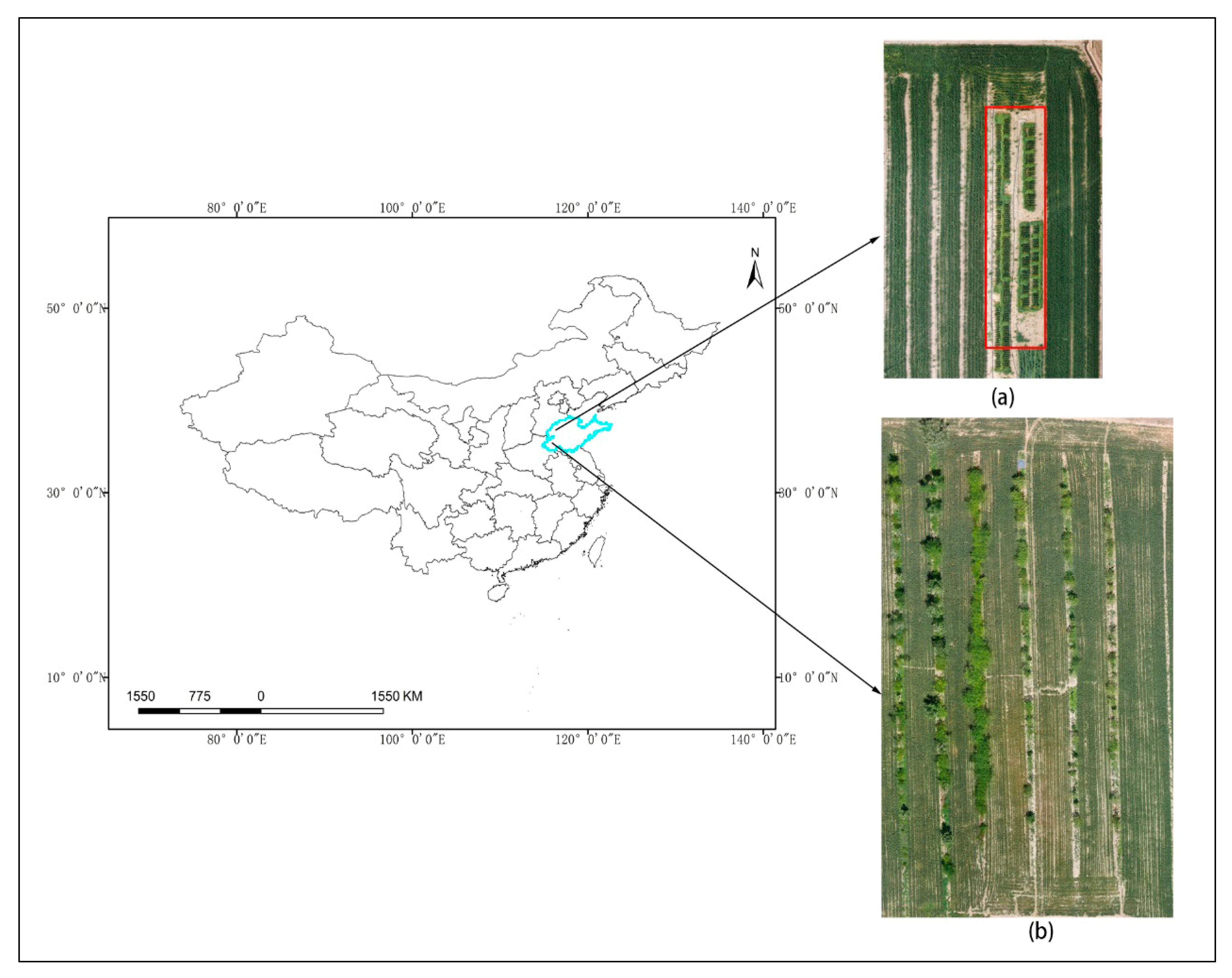

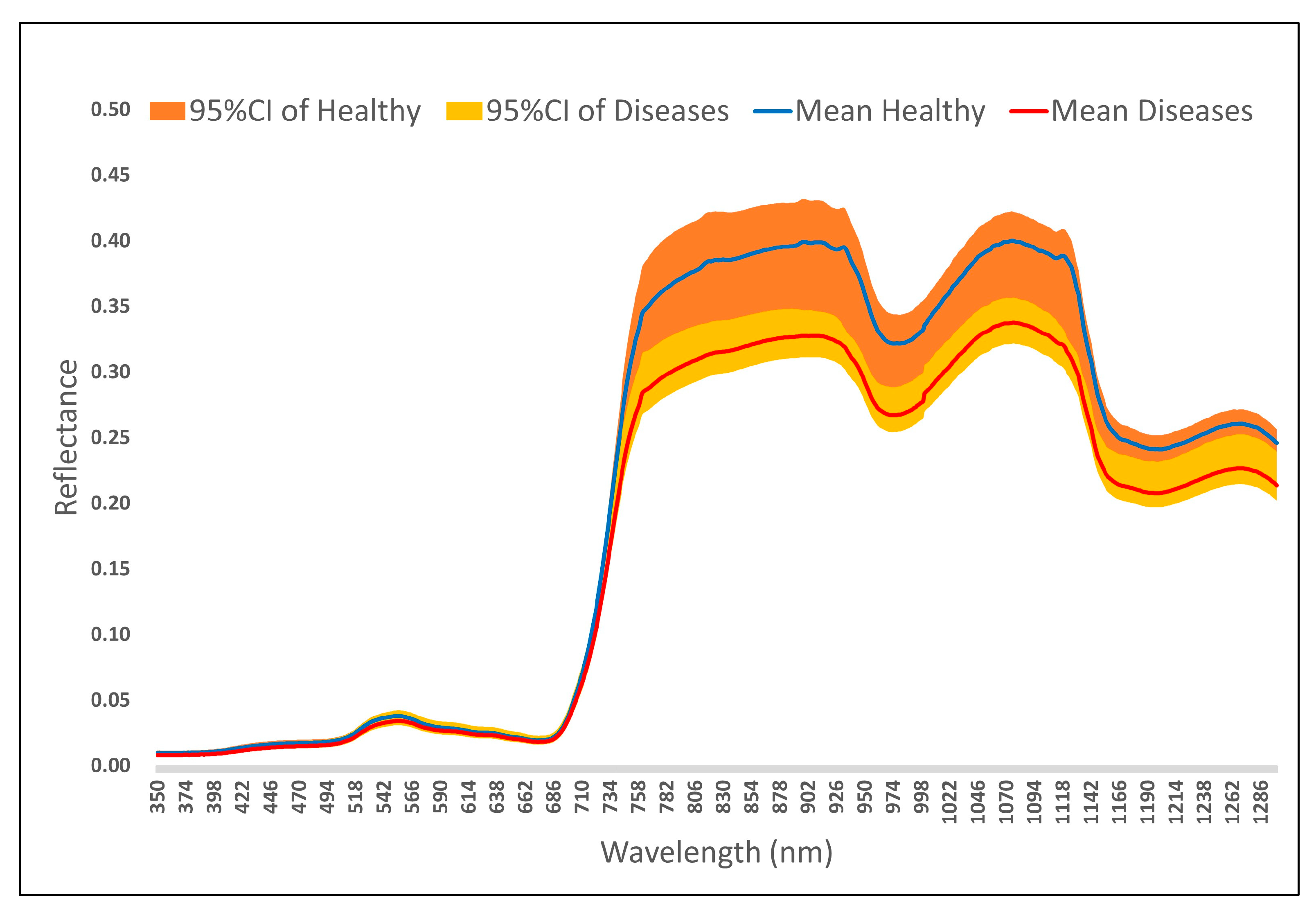
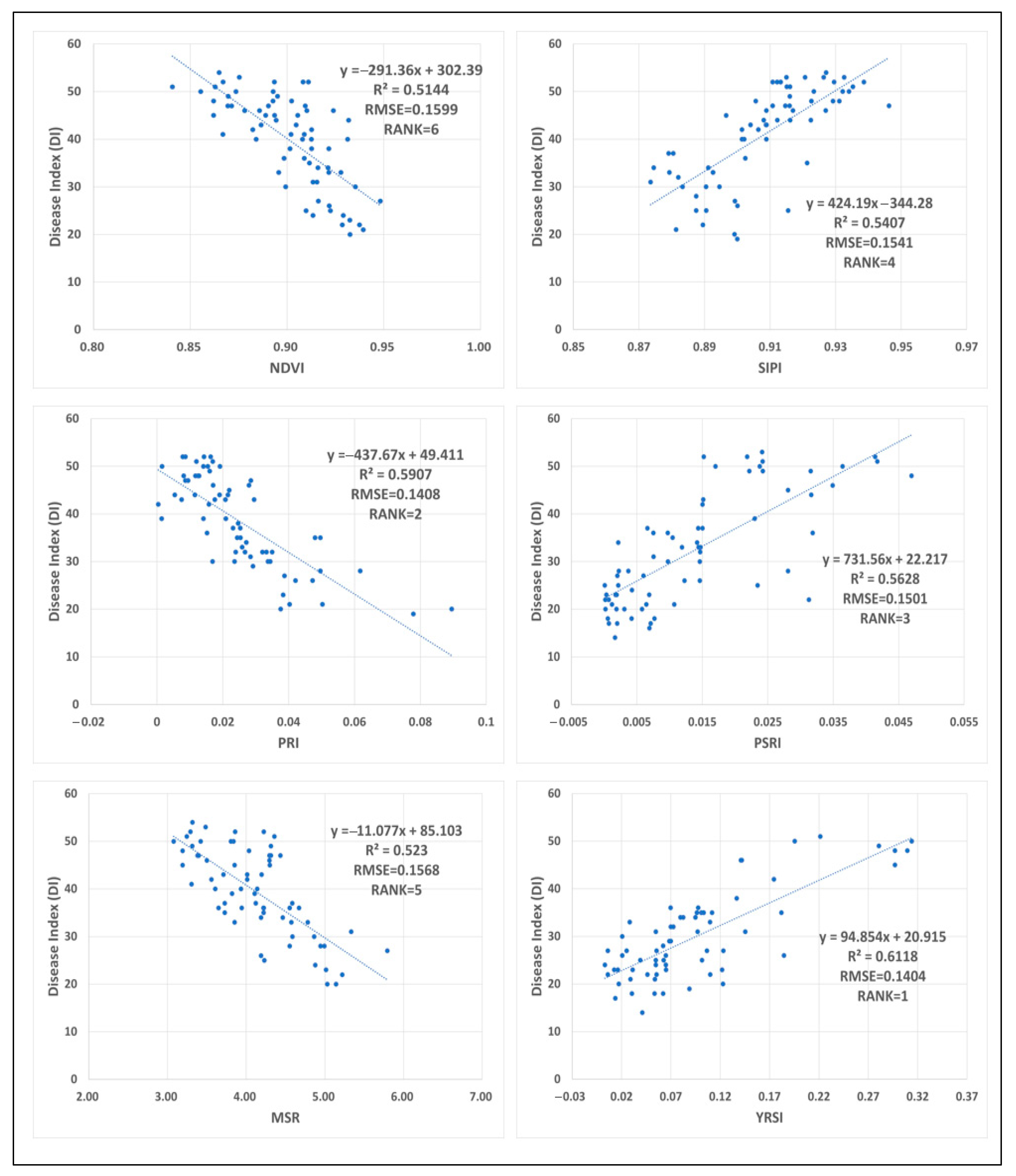
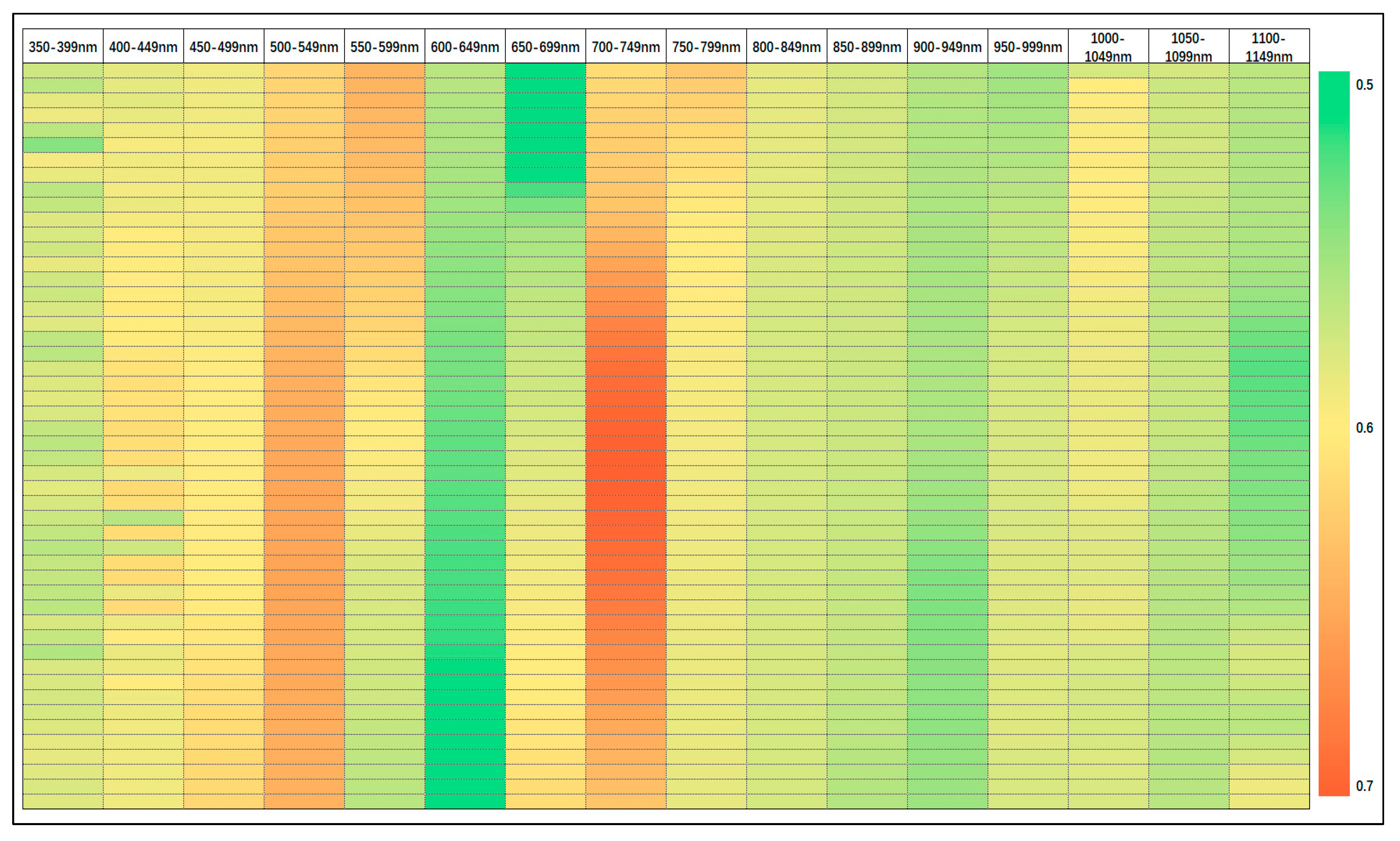
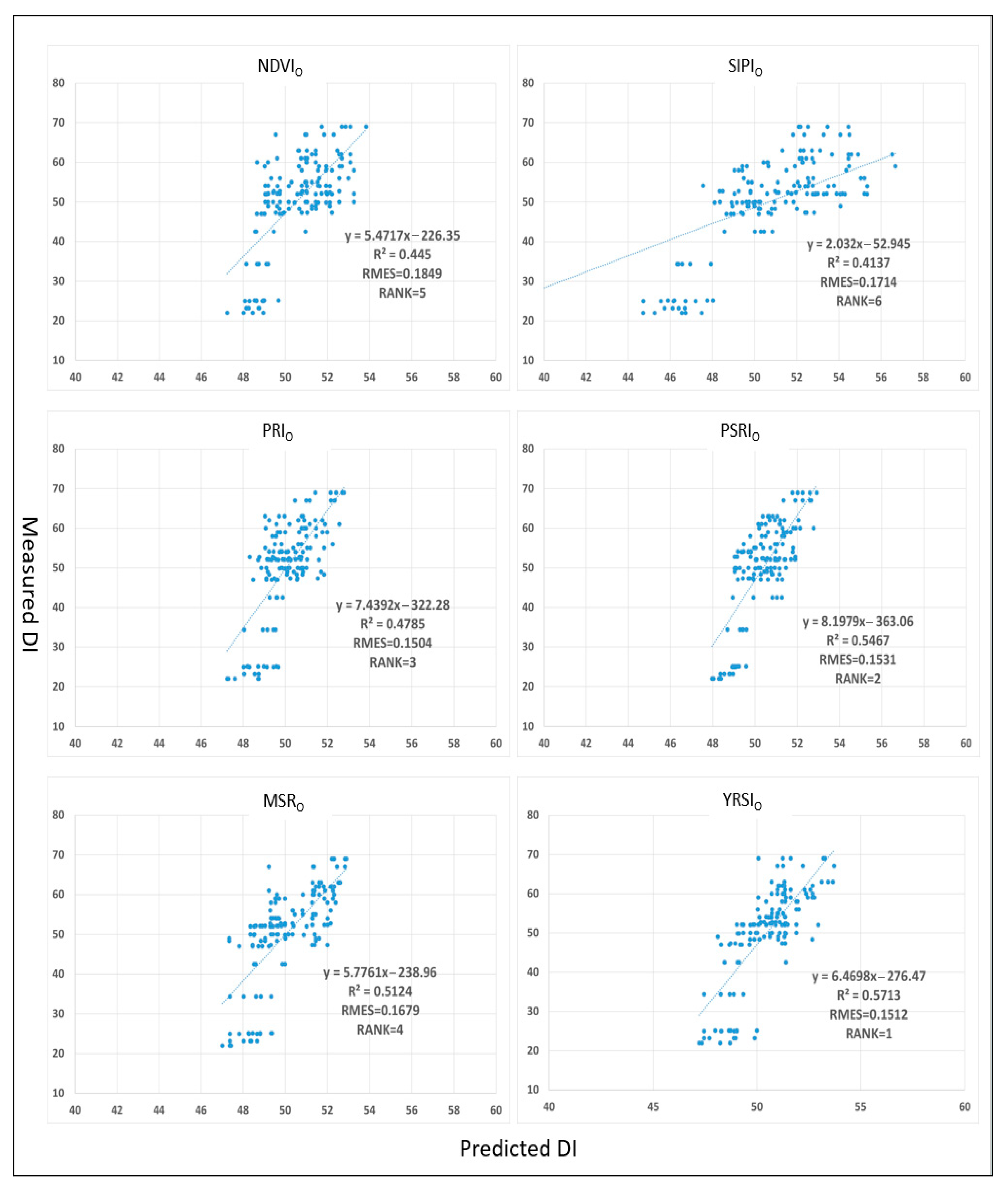
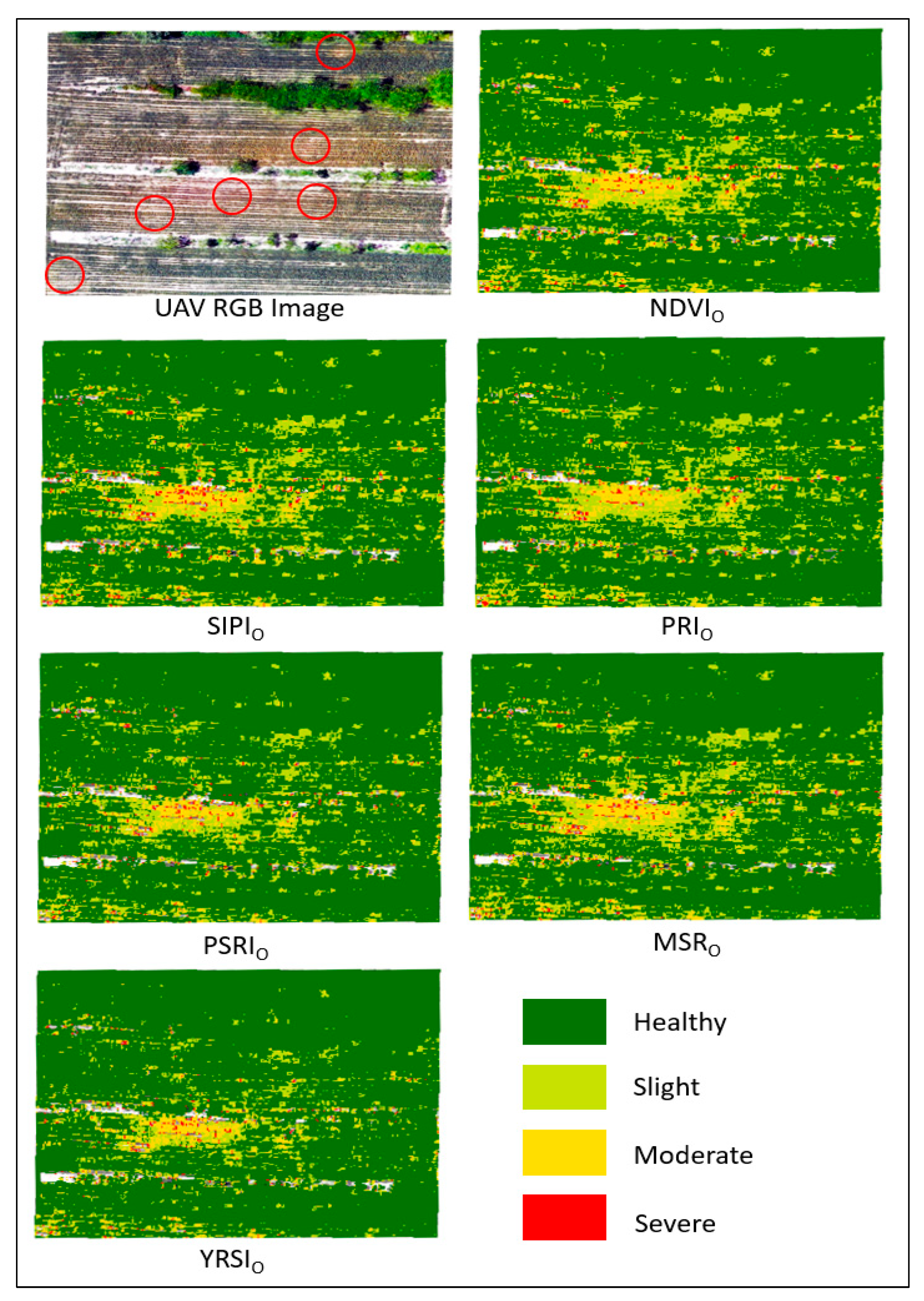
| Index | Slight | Moderate | Severe |
|---|---|---|---|
| NDVIO | 68.7 | 67.1 | 70.6 |
| SIPIO | 67.1 | 67.5 | 69.4 |
| PRIO | 75.8 | 79.5 | 72.2 |
| PSRIO | 83.1 | 83.5 | 77.3 |
| MSRO | 68.1 | 70.5 | 75.3 |
| YRSIO | 79.8 | 83.8 | 85.2 |
Disclaimer/Publisher’s Note: The statements, opinions and data contained in all publications are solely those of the individual author(s) and contributor(s) and not of MDPI and/or the editor(s). MDPI and/or the editor(s) disclaim responsibility for any injury to people or property resulting from any ideas, methods, instructions or products referred to in the content. |
© 2025 by the authors. Licensee MDPI, Basel, Switzerland. This article is an open access article distributed under the terms and conditions of the Creative Commons Attribution (CC BY) license (https://creativecommons.org/licenses/by/4.0/).
Share and Cite
Wang, M.; Han, D.; Gao, R.; Liu, T.; Feng, W.; Wang, F.; Zhang, Z.; Zhang, J. From Experimental Field to Real Field: Monitoring Wheat Stripe Rust Based on Optimized Hyperspectral Vegetation Index. Remote Sens. 2025, 17, 3798. https://doi.org/10.3390/rs17233798
Wang M, Han D, Gao R, Liu T, Feng W, Wang F, Zhang Z, Zhang J. From Experimental Field to Real Field: Monitoring Wheat Stripe Rust Based on Optimized Hyperspectral Vegetation Index. Remote Sensing. 2025; 17(23):3798. https://doi.org/10.3390/rs17233798
Chicago/Turabian StyleWang, Meng, Dongrui Han, Rui Gao, Tao Liu, Wenjie Feng, Fei Wang, Zhuoran Zhang, and Junyong Zhang. 2025. "From Experimental Field to Real Field: Monitoring Wheat Stripe Rust Based on Optimized Hyperspectral Vegetation Index" Remote Sensing 17, no. 23: 3798. https://doi.org/10.3390/rs17233798
APA StyleWang, M., Han, D., Gao, R., Liu, T., Feng, W., Wang, F., Zhang, Z., & Zhang, J. (2025). From Experimental Field to Real Field: Monitoring Wheat Stripe Rust Based on Optimized Hyperspectral Vegetation Index. Remote Sensing, 17(23), 3798. https://doi.org/10.3390/rs17233798





